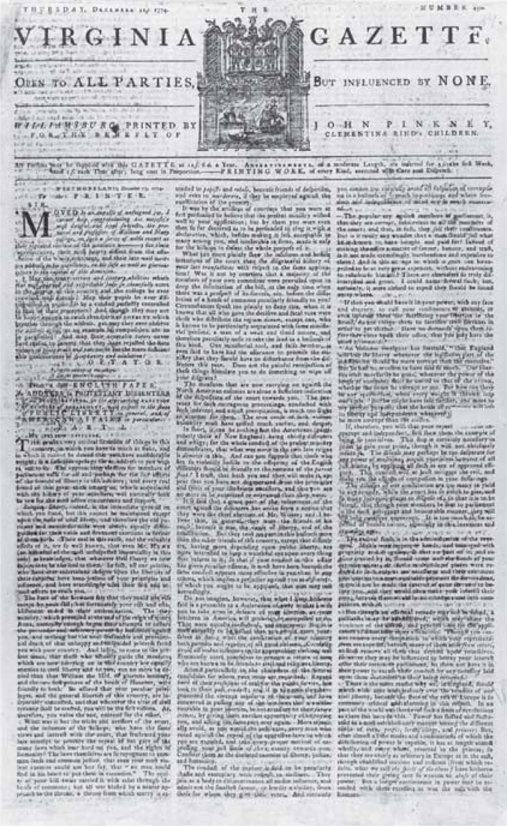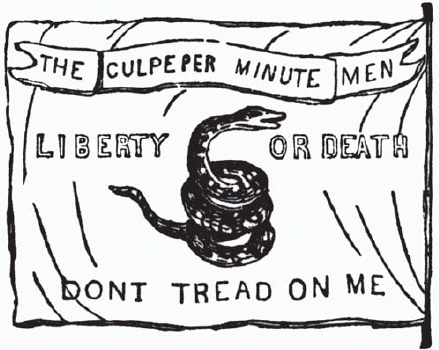
When Dunmore returned to Williamsburg on December 4, he learned that his new daughter had been born the day before. But the other news was bad. On September 22, when Lewis had reached his 12th W. Va. Camp, the Continental Congress had asked American merchants to cease purchasing British goods. On October 15, the day Dunmore had reached his 5th Ohio Camp, it had issued a Declaration of Colonial Rights. On October 20, when Lewis had reached his 4th Ohio Camp, it had voted to create the American Association, a permanent league of the 13 colonies. And on October 26, as Crawford had marched north to Seekunk, it had dissolved with an announcement that it would reconvene on May 10, 1775 unless the British government repealed its intolerable legislation.

The Dec. 22, 1774 issue of the Virginia Gazette contained the Fort Gower Resolves (beginning lower right). (Courtesy of the Virginia Historical Society).
On December 22, the Fort Gower Resolves appeared in the Virginia Gazette like a thunderbolt in the western sky. It was the first public announcement that, if the British did not satisfy the colonists’ grievances, they would face an American army. Lewis’s Southern Army officers soon issued joint statements expressing their approval.
At the same time, Boston newspapers were contrasting the militiamen who had fought at Point Pleasant with the British regulars who occupied their town. “The professed design of Britain in maintaining standing armies in America,” wrote one, “was the protection of the colonies.” But none of the 7,000 British soldiers in America had marched west to fight the Indians. “The battle between the brave Virginians and their savage neighbors,” it continued, showed that the colonies “are able and willing to defend themselves… The real design of keeping a standing army in America,” it ominously concluded, “was not protecting but enslaving the colonies.”

A year after Col. John Field fell at Point Pleasant, his Culpeper County militiamen fought under this banner at Great Bridge. The engraving is from Benson Lossing’s Popular Cyclopedia of United States History. (Author’s collection)
After Seekunk, the Mingos remained hostile to the Virginians, but Logan went on no more raids. The Shawnees, moreover, honored their agreement by returning captives to Fort Blair. In 1775, they brought John Field’s son Ezekiel, who had, he reported, been “treated cruelly” and William Robinson, whom Logan had saved from the Burning Ground. George See’s sister Elizabeth, now 20, returned as well, leaving behind with the Shawnees a four-year-old son and two-year-old daughter. And so did others, such as 15-year-old Richard Sparks, who would in time command the US Army’s 2nd Infantry Regiment.
In March, when the Fort Gower Resolves were read aloud in the House of Commons to outraged members of Parliament, the settlement of Kentucky began. On March 8, Harrod and his men began the long journey back to their abandoned cabins in Harrodsburg, Kentucky’s first settlement. On March 18, Boone and 31 axemen began blazing the Wilderness Trail through the Cumberland Gap. Tens of thousands of Virginians would follow them to Boonesborough and other Kentucky settlements.
As Harrod’s and Boone’s settlers went west, Americans east of the Appalachians waited in vain for good news from Britain. On March 28, Dunmore issued a proclamation forbidding the election of Virginia delegates to attend the Continental Congress when it reconvened. Protesting Virginians, led by Patrick Henry, threatened to use the colony’s militia to prevent its enforcement. “I once fought for the Virginians,” an angry Dunmore responded, “but, by God, I would let them see that I could fight against them.”
Then the fighting began. On April 19, when Gage attempted to repeat his seizure of Massachusetts militia arsenals, more than 300 British soldiers and American militiamen were killed or wounded at Lexington and Concord. When the news reached Virginia on April 29, 150 Hanover County militiamen, led by Henry, marched on Williamsburg. On May 6, Dunmore and his family fled. When the news reached Hannastown on May 16, St. Clair and others gathered at the courthouse, where they issued the Hannastown Resolves, the first published call for Americans to form an army to fight the British.
On July 3, Washington arrived in Cambridge, Mass., where the Continental Army had been assembled to drive the British from Boston. Waiting to greet the army’s commander were Cresap and 150 riflemen waiting, who had marched more than 500 miles to greet him. On August 8, Daniel Morgan arrived with 96 more.
To suppress the rebellion in Virginia, Britain’s royal governor tried to use the Ohio Indians. At Dunmore’s request, Connolly sent a letter to White Eyes, asking him to lead the Ohio Indians against the western settlers. But the puzzled Delaware chief showed it to John Gibson. When news of the letter spread, St Clair and an army of furious frontiersmen took control of Pittsburgh.
Connolly fled to Virginia, where Dunmore had assembled an army of British soldiers and American loyalists that was fighting to retain control of the colony. But on December 9, the rifles of Culpeper County militiamen defeated them at the battle of Great Bridge. Continental Army soldiers led by Andrew Lewis and Adam Stephen then drove Dunmore from his last Virginia base at the battle of Gwynn’s Island on July 9, 1776.
During the Revolutionary War, Butler, Clark, Lewis, Daniel Morgan, Posey, St Clair, and Stephen all would become American generals. Christian, Crawford, Gibson and Matthews would command regiments. Campbell, Sevier and Isaac Shelby would win fame as commanders of militia forces.
For a time, it was uncertain whether the war would spread west of the Appalachians. On March 2, 1776, as Americans were considering independence, White Eyes addressed the Continental Congress. He would try, he said, to form a union of the Ohio Indians, which Congress should recognize as the 14th state of the new United States.
For two years, while the British debated whether to seek the aid of the Ohio Indians, the Mingos battled the Americans alone. On Christmas Day, 1776, Pluggy and 30 warriors attacked Harrod’s new settlement, and a nearby party led by John Todd. But three days later, the Mingo chief fell fighting.

After leaving Virginia, Dunmore returned to Dunmore Park, his estate near Airth in Scotland. His summerhouse at the estate, known as The Pineapple, survives to this day. (Author’s collection)
Many prominent British leaders, including William Pitt, who had been prime minister during the French and Indian War, thought that British use of the Indians against the Americans would be shameful. But in June 1777, the commandant at British Fort Detroit received orders to urge the Ohio Indians to attack American settlements.
Events then favored the British. On November 10, 1777, Indians killed a militiaman near Fort Randolph, which had been built at Point Pleasant to replace Fort Blair. Infuriated soldiers at the fort then killed Cornstalk, who was visiting on a peace mission. On March 27, 1778, McKee, Girty, and Elliott fled from Pittsburgh to join the British. McKee, as chief British agent among the Ohio Indians, and Elliott, as his deputy, would guide the actions of Britain’s Indian allies during the Revolutionary War. Girty, who would lead the Indians in many engagements, would become the most hated man on the frontier.
By the end of 1778, White Eyes was dead, and most of the Ohio Indians had joined the British. But by then, thousands of settlers had emigrated to Kentucky. Fighting of unsurpassed brutality raged, in which the dead included Crawford, Floyd, and Todd. But the Kentuckians, led by Clark, prevailed in campaigns that allowed the United States at the end of the Revolutionary War to claim borders that extended to the Great Lakes and the Mississippi River.
Aided covertly by McKee and Elliott, the Ohio Indians fought on without the British, first against Kentucky militiamen, and then against soldiers of the new US Army. In 1791, when St Clair became the US Army’s commanding general, he led it against the Ohio Indians. At Wabash, they destroyed his army and killed Butler, his second in command. But in 1794, a reborn US Army, commanded by Maj. Gen. Anthony Wayne, defeated them at Fallen Timbers.
Sixteen years of peace followed, during which Ohio became a state and Indiana, Illinois, and Michigan territories. Then Puckeshinwa’s sons the Prophet and Tecumseh renewed the fighting, first at the 1811 battle of Tippecanoe and then during the War of 1812. Thirty-nine years after Point Pleasant, it finally ended at the 1813 battle of the Thames. There an army of Americans and allied Indians, including 1,000 Kentucky volunteers led by Isaac Shelby, and 150 Shawnees led by Black Hoof, destroyed a British and Indian army, killed Tecumseh, and brought a permanent peace to the Ohio Country.